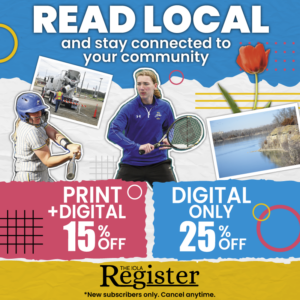Iola may not have a Golden Gate Bridge in its future, but there’s no reason the community cannot replicate the forward thinking that many in San Francisco had nearly a century ago.
“When you think about it, the Golden Gate Bridge was built simply as a piece of infrastructure,” David To-land said Thursday as part of a Vision Iola meeting. But the bridge’s picture-perfect architecture and de-sign, particularly with how it fit in the city’s landscape, has given San Francisco its identity for the past 74 years.
Such an identity is considered “associative,” ex-plained Carisa McMullen of Landworks Studio.
The example at Thursday’s meeting was meant to spur ideas on how to improve Iola’s community identity, particularly with signage.
Landworks is facilitating a three-pronged approach to the Vision Iola planning process. The Olathe-based firm is assisting the city and Thrive Allen County in the effort, which later will examine ways to improve Iola’s downtown business district and parks and trails.
The first focus — community identity — runs through February.
A group of about 40 Iolans attended Thursday’s meeting to discuss whether the city’s existing signage was adequate — most agreed that it was not — and how to improve Iola’s physical im-age.
They brainstormed on a number of ways Iola gets its identity by looking at the community through five prisms — cultural, historical, industrial, natural and associative.
Iola’s cultural identity, for example, might come from the Bowlus Fine Arts Center or its schools. For history, Buster Keaton and Maj. Gen. Frederick Funston were mentioned; agriculture and the Russell Stover Candies plant both could be considered part of Iola’s industrial base; and the Neosho River and Prairie Spirit Trail both are significant elements of the community’s natural environment. Any or all of those also could be included with Iola’s associative identity, they noted.
McMullen explained Vision Iola focused on community identity and sign-age because such plans are “actionable” and highly visible. A community’s signage is viewed as its unofficial host in many aspects, McMullen explained.
“Not everybody can be greeted when they come to town,” she said. Effective signage tells visitors “to come on in. We’re glad you’re here.”
Dale Stafford, a designer with Landworks, illustrated different types of signage: monument-sized, primary and secondary way-finding, those that identify specific markers and banners.
An effective signage campaign typically has a common palette in terms of colors and lettering, Stafford said.
McMullen and Stafford will take the comments from the meeting, plus continue to gather input from a survey available at visioniola.com, to develop a signage campaign for Iola.
Iolans are welcome to complete the online survey through Wednesday.
Results, plus a listing of funding opportunities to pay for better signage, will be announced at a meeting Feb. 24.
Design concepts will be shared with the group at the meeting, Toland said.






